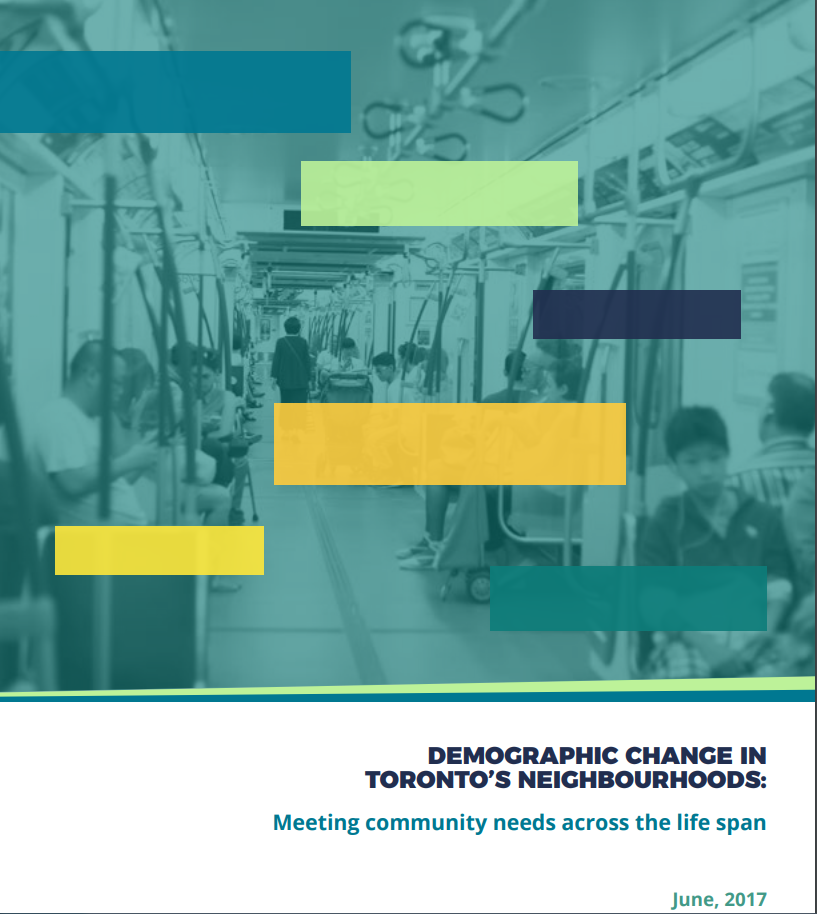Today, it’s hard not to think about how countries all over the world are rapidly ageing. In 2015, 8.5 per cent of the world was over 65, in 2030 it will be 12 per cent and in 2050 it will be 16.7 per cent. It’s not only countries that are ageing, but increasingly our cities are as well as more and more older people migrate towards living in urban centres.
In the coming decades, our cities will continue to attract older residents and will increasingly be challenged to support them and enable them to live and age well. In fact, the ageing of our urban centres is already underway. Today, 500 million urban dwellers are aged 65 or over – more than half of all older people worldwide. People over 60 are also the fastest-growing group of urbanites. That’s as true in Toronto as anywhere else.
A recent report from Social Planning Toronto noted that that the City of Toronto is ageing faster than ever in its history, and it’s not as prepared for this demographic shift as it should be. With older Torontonians growing 33% between 1996 and 2016, the City of Toronto could be doing a lot more to create safe, supportive and empowering spaces in which we can all age well.
Indeed, despite the incredible growth of our cities, they continue to present physical, social and economic barriers for their older residents. Therefore, if we want to support our older adults to lead healthy, engaged and productive lives well into their later years, we need to start supporting them locally where they live, including in our cities.
Cities have the potential to support the capabilities and contributions of older adults, but they will only realize it if they adopt policies and build public infrastructure including buildings and spaces that meet the needs of residents of all ages. Transportation is one of the most critical and consequential forms of infrastructure that a city can invest in to support older adults to be fully integrated members of their communities. Indeed, efficient, reliable, affordable and popular transit options not only support older people to stay engaged and active in their communities, but also to remain socially connected.
For the most part, driving remains the primary form of transportation for older adults, but most people over the age of 65 outlive their decision to stop driving by a decade. This leaves an enormous gap – and opportunity – where effective transportation options can help older adults maintain their independence. While major cities across Canada have transit programs that are more geared towards those with significant physical limitations, this doesn’t often meet the greater need for more flexible community-based transportation options that are far more affordable than taxis and more geared to meeting the unique needs of older adults. Indeed, to ensure that older Canadians can remain engaged and active members of their communities, we should make a variety of transportation options available to maximize their participation in all aspects of civic life.
Improving transportation services, however, is just one of the areas cities can invest in and think more creatively around to support their older residents. Truly, there exists a range of other supports that cities can develop to enable greater independence amongst their older residents. Ten years ago, the World Health Organization (WHO) launched an international program to help cities become more age-friendly. The WHO defines an Age-Friendly Community as one that recognizes the great diversity amongst older persons, promotes their inclusion and contributions in all areas of community life, respects their decisions and lifestyle choices, and anticipates and responds flexibly to ageing-related needs and preferences. It further defines the eight dimensions inherent to age-friendly communities that in addition to transportation include social participation, respect & social inclusion, civic participation & employment, communication & information, community support & health services, outdoor spaces & buildings, and housing.
In 2016, the City of Toronto received the WHO Age-Friendly City designation as one of more than 59 municipalities across Canada and 500 around the world that are pursuing initiatives to make their environments more age-friendly. This was a proud moment for me since three years earlier I was invited to help the City of Toronto Staff to develop its first Seniors Strategy. The strategy was developed following the WHO’s framework for age-friendly communities, and was designed to emphasize equity, respect, inclusion and quality of life to inform its services and initiatives. Our first strategy was not only passed unanimously by City Council, but virtually all of its 95 recommendations have now been fully or partially implemented.
I have been privileged to consult with many other communities across Ontario that are also seeking to become WHO-designated age-friendly communities. When people ask me why we have been so effective in Toronto to date, I think it’s been the collaborative approach with which we developed our strategy in the first place. First of all, older Torontonians were fully engaged, consulted and invited to shape the process right from the start, working hand in hand with City of Toronto staff, agencies and related local service providers to co-create a plan that could be both meaningful and impactful to them. Once our strategy was passed by City Council, the Toronto Seniors Forum and others advocated that we establish an Accountability Table to provide oversight and ensure that the Strategy was implemented and met its objectives. It was an honour to be invited to Co-Chair this table with Councillor Josh Matlow, the City’s designated Seniors Advocate. Supported through the tireless efforts of Andrea Austen from the City of Toronto, our table consists of over 50 individuals including City of Toronto staff, local agency leaders, experts on all aspects of ageing, and older adults themselves who meet monthly to learn and inform ourselves and consider how we can continue to turn good ideas into action.
Even though the City of Toronto has been successful at creating spaces, services and initiatives to make the city much more age-friendly, the Accountability Table is not resting on any laurels and is now very busy at work over the summer getting ready to put forward its Version 2.0 of the City of Toronto Seniors Strategy that will go before City Council this fall. We are thrilled that so far our second iteration is getting a lot of attention and input with more than 7,000 older Torontonians participating in our consultations to date. We intend to build on strengths and make even bigger strides to ensure that we move forward in the right direction to ensure Toronto can continue to become one of the best cities to grow up and grow old in.
Date modified: 2017-07-11


